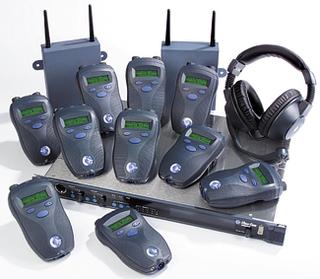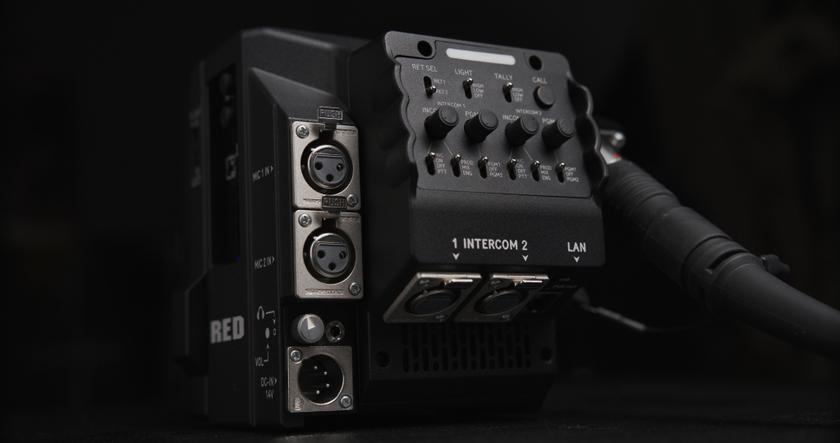Clear-Com CellCom 10
It's been a wonderful experience, watching broadcast technology develop during the past 40 years or so. It's true that I've been a professional in the industry for only 25 years, but I've been a loyal follower much longer. I have witnessed the literal evaporation of videotape from two-inch all the way down to quarter-inch and then—gone! Cameras have gotten smaller, use less power, they work most of the time, and the resolution is awesome. Then there are the computers, but let's not go there.
Through it all, one basic element has evolved with minimal fanfare: communication among production crew members. The evolution of intercommunication systems has been as steady as any component of television production, though often it seems that the communication element is taken for granted. While "eye candy" gets most of the fanfare, clear and reliable communication is the technology that makes it all go so smoothly.
Clear-Com Communication Systems of Alameda, Calif. is a leading manufacturer of broadcasting industry intercommunication systems. The Clear-Com CellCom 10 is one of their latest offerings in the field of wireless intercom. Combined with the CEL-BP beltpack, the CellCom 10 offers a new level of flexibility and service.

The Clear-Com family of CellCom 10 productsFEATURES
The Clear-Com CellCom 10 allows users to freely roam around production facilities, sports venues, or any place else where wireless communications is a must. Although wireless communications is nothing new, with cell-technology, intercom system designers can create networks with more range, more channels, and higher reliability than ever.
The system features a 1 RU-sized base station, which accommodates as many as 10 wireless beltpacks. Point-to-point and small group wireless communications are possible, and there are up to six communication routes per beltpack. The system can accommodate party-line beltpacks; four-wire devices, a program audio source and a stage announce output. A single base station can accommodate up to 10 remote transceiver/antenna modules, allowing the strategic placement of antenna modules for maximum flexibility. The transceiver/antenna modules can be located up to 1,000 meters from the base station using 24 AWG, or up to 500 meters if using 26 AWG CAT-5 cable, thus eliminating the need for expensive RF cable. Each beltpack can be labeled with up to five characters, and communication groups can be created, customized, and assigned to beltpack keys.
The units operate in the unlicensed 1.92-1.93 GHz band, and frequency hopping technology automatically locates clear spectrum. The system is secure in that beltpacks are registered to individual base stations, and two base stations can connect locally.
The CellCom 10 system consists of three units: the base station, the wireless beltpack and the antenna modules. The base station acts as an interface between wireless beltpacks and other audio sources, while the transceivers/antennas provide zones in which the wireless beltpacks can operate. Each transceiver/antenna can support up to five beltpacks in full duplex, and the beltpacks can roam between the zones. Each base station has two transceiver/antenna ports. When optional five-port antenna splitter units are used, each base station can accommodate up to 10 transceiver/antenna units. The wireless beltpacks can roam between the "cells." When signal strength starts to weaken, this condition is detected, and if an alternative stronger signal is present, the beltpack "hands off" its signal to the stronger available signal.
The CEL-BP beltpacks appear to be very durable and the antenna is located inside the unit to assure long life. There are two multifunction buttons on the very top, which are multi-functional and provide channel selection, volume control and other programming functions. Located next to these, and in clear view, are the program tally and reply LEDs for each audio route. A rechargeable AA battery pack slides neatly in the beltpack from the rear of the unit. Battery life is reported to be between eight and 10 hours, using rechargeable NiMh cells. The front of the CEL-BP reveals the high-contrast, backlit LCD screen. This displays audio routing information, identity label, battery life, channel access and RF signal strength. Located below the display are the Menu/Page up-down buttons, along with the PTT combo button. Finally, at the bottom of the beltpack, you'll find the data port, four-pin headset connector, battery charging plug and power button.
The 1 RU CellCom 10 Base Station has a familiar look. The left front of the unit has a four-pin headset plug, along with controls to talk/listen to channels A and B. There is a partyline listen and reply feature as well. The center of the unit has LEDs for indicating status of all possible beltpack units.
Menu choices are selected and entered by the "scroll/enter" multifunction knob. Located on the rear of the base station are partyline I/O 3-pin XLRs for channels A and B, along with 3-pin XLR connectors for program in, as well as the stage announce output. In addition there's DB-9 connector for stage announce relay operation, four RJ-45 four-wire/Eclipse Matrix ports, an RJ-45 for base station loop, an RJ-45 for LAN connectivity, a DB-9 for PC programming, and two more RJ-45s for transceiver/antenna unit connectivity.
The transceiver/antenna unit is housed in a metal chassis, with four tabs extending outward for easy mounting to any flat surface. There's an RJ-45 connector on the bottom of the unit for connectivity to the CellCom 10 base unit, along with a power status led and external power connection. The units I received for evaluation were powered via the CAT-5 cable.
IN USE
For test purposes Clear-Com shipped me a CellCom 10 base station, two CEL-BP beltpacks, and two transceiver/antenna units. There was no paper manual, but documentation was readily available on the supplied product CD-ROM. Due to the flexibility and complex feature-set of the CellCom 10, Clear-Com asked that one of their representatives "swing by" to provide a "quick start" of the unit. Initially, I thought this was probably not necessary. But after reviewing the capabilities of the unit, it didn't seem like such a bad idea.
When the field representative arrived, setup was a piece of cake. Connectivity could not have been easier. After a brief RF survey and a few programming keystrokes, the units were up and running. The CellCom 10 system is robust and flexible. In my opinion, while not overly complicated, one must fully understand the architecture to fully benefit from this system. I must tell you though, the Clear-Com guy made it look easy. I knew that I was going to like the unit when I found the one-page instruction sheet titled: "CellCom-10 for People in a Hurry."
One of the first things I tried was the "distance" test. With program audio feeding the base station, I placed the antenna unit in my office window and went outside to listen to the program audio channel. The sound was very clear and volume was not an issue. I moved out to about 200-feet, with the signal never fading or dropping out. Obviously, this was the "line of sight" test. For my next distance test, I began walking up the hallway from my office. After about 180-feet, and after two turns, the unit started to drop out. I must say at this point, if I were going to utilize the unit in this manner, I would have obviously placed one of the cell-type transceiver/antenna units in this general location. Basically, I was forcing the unit to fail.
Finally, for the "distance test" I operated the units through double block studio walls, combined with about six or seven gypsum board office walls. This worst-case test yielded a good working distance of about 150-feet. To simulate an actual loss, I un-plugged the CAT-5 cable from the transceiver/antenna unit. I heard some beeping, then silence, then a tone for a half second before the unit established audio connection once again. This happened quickly, and was non-offensive. I found out later that the tone was an automatic null taking place.
Fast FactsApplication
Wireless Intercommunication
Key Features
Cellular-based system, cost-effective, full feature set
Price
MSRP as tested, $15,000 to $25,000
Contact
Clear-Com Communication Systems
510-337-6600
www.clearcom.comTo evaluate the quality of the audio, I figured the best way is the old fashioned one.
I decided to sweep the units for frequency response. Using a Minerator pink noise generator to feed the program input of the base unit, and a Minilyzer to analyze the audio spectrum from the belt pack's four pin XLR, I was able to get a graphic display of the unit's frequency response. From 25 to about 6.5 kHz, the curve was flat within approximately 1 dB. As the frequency approached 8 kHz, the levels were down about 50 db. This seems more than adequate for any voice or program information.
There are a couple of considerations in setting up the system that I should point out. (1) For five beltpack unit reliability, a robust signal must be available; for marginal signal strength, four beltpacks may be more practical. (2) Care must be taken when mounting any intercom antenna units, as the RX/TX antennas protrude above the units and placement can be critical with regard to antenna proximity to reflective or absorptive obstacles.
SUMMARY
The CellCom 10 is a very powerful intercom system. And while it would be impractical to try and list every feature available on this unit, I've tried to touch on the most basic functions, along with evaluation of its ease of installation and overall performance.
While reviewing the units, I did come up with a few questions for Clear-Com. It seems to me that instead of antenna connectivity that resembles a LAN (parallel) set-up, large venues would benefit from "daisy chain" connectivity between transceiver/antenna units. According to Clear-Com, that's already been considered, but there are some issues yet to be overcome with this type of architecture. Another item I asked about was being able to invert the display on the beltpacks. Clear-Com says that this might be possible with later releases. It should be noted that for connectivity between transceiver/antenna units, they recommend shielded CAT-5 cable.
Joey Gill is chief engineer at television station WPSD in Paducah, Ky. He has been with the station for 25 years and has worked in broadcasting since 1977. He may be contacted at respond2jgill@yahoo.com.
Get the TV Tech Newsletter
The professional video industry's #1 source for news, trends and product and tech information. Sign up below.













